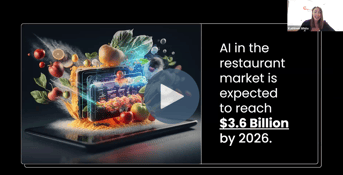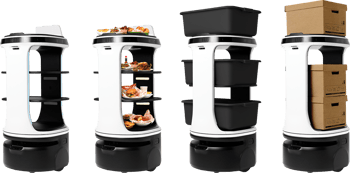Once just a whisper in the hospitality world, cloud or "ghost" kitchens have become a mainstay in the restaurant industry of late. Before the pandemic, only 15% of restaurants used this business model. By May of 2020, that number reached 51% and continues to thrive. Those numbers suggest that ghost kitchens, far from a fad, are destined to become an industry fixture.
Yet by their very nature, they remain a low-visibility venture. Ghost kitchens are a little hard to grasp, so check out our full ghost kitchen explainer here if you are new to the concept. One thing to know about cloud kitchens: they are all about real estate and delivery. Ghost kitchens started as a way of capitalizing on space that at the time seemed unusable: parking lots, old warehouses, unappealing rental properties near interstates. For many of the companies who own cloud kitchens spaces, restaurants are the means to profitable ends. In other words, their core mission isn't hospitality—not in the sense that conventional restaurants use that word, anyway.
>>>RELATED: Everything you need to know about "cloud" or ghost kitchens
In the end, a ghost kitchen will only be as successful as its partnerships. The space you partner with needs to have its goals aligned with your restaurant’s. Do not be timid about shopping around or walking away from a kitchen space that just doesn’t feel right. Remember, this business model grew 36% from March to May 2020. That's nuts. Property owners, delivery platforms, and most of all restaurateurs are still working out the kinks.
Are ghost kitchens the right next step for your restaurant? There are plenty of factors to consider when starting a ghost kitchen, so here are the biggest pros and cons to look out for as you explore this dining option.
Benefits of a cloud kitchen
It’s flat-out cheaper, and cheaper is good. On average, it takes about $750,000 to start a restaurant. Cloud kitchens slash those costs immensely because as a delivery-only business, you can use a shared space, or one in a less desirable location. And since you don’t offer in-person dining, you don’t spend on tables, cutlery, or even a front of house staff. Without these costs, your startup budget plunges. Less upfront investment makes it easier to take risks, experiment with your offerings, and refine your menus with less pressure.
Startup is a snap. Because cloud kitchens are so much leaner and cheaper, they’re also much faster to launch. Raising money will take far less time, and you don’t have to worry about a restaurant’s physical build-out since the space you need has already been outfitted. You can nail down a menu, hire and train your kitchen staff, pick a suitable delivery-friendly payment platform, and you’re off to the races.
They let you expand your delivery reach. Cloud kitchens make it easy for your restaurant to service new areas without building out new locations. Generally speaking, they target delivery customers within a 3-mile or 15-minute driving radius. If there is a neighborhood you’ve wanted to get into or a city that has felt out of reach for expansion, ghost kitchens provide a lower risk opportunity. Each additional ghost kitchen can produce up to $12k in additional weekly sales.
Diners only want you for your take-out right now, anyway. Like it or not, people are increasingly opting to order delivery, even before the pandemic accelerated the trend. Since ghost or cloud kitchens are built for online ordering only, they meet customers where they are. With a ghost kitchen, you also don’t have to depend on foot traffic or in-person sales, keeping workers safe while minimizing the financial threat of a shutdown.
Drawbacks of a cloud kitchen
You don’t get to play host. Let's face it, for many operators, people are the fun part. Many restaurateurs are drawn to human connections and daily joys of hosting. Hospitality becomes less of a factor in a cloud kitchen business, which does all its transactions online. You’ll have to work harder to find the human elements that drew you to this work in the first place.
You depend on your digital platform. Living and dying by online ordering usually means partnering with a third-party service to host your restaurant on its platform and provide the courier to execute the delivery. Shop carefully. Many take large commissions fees or just don’t work in the best interest of restaurants or the people they employ. Ask lots of questions and don’t settle for a third party that isn’t transparent about the cut they take.
It’s hard to be visible as an invisible restaurant. Without signage or a dining room, your restaurant will live only on… well, the cloud. Chowly has recently reported that more than 100,000 ghost kitchens on digital platforms, not to mention all the brick-and-mortar restaurants competing for the customer’s attention. You can have the best ghost kitchen concept in the world, but if you can’t stand out from the crowd, you may never make it off the ground.
Having a cloud kitchen means investing in more marketing to cut above the noise. That might mean spending extra money on in-app ads, investing in a website, social media management, and email campaigns to drive hype. Partner with a third-party app that gives you access to your data and customer info to use it in your marketing efforts. Otherwise, you won’t have any control over your customer relationship.
Menu items have to travel. You may have a killer hot sandwich on your menu that loses its pop after a 10-minute delivery run in a New York winter. In a cloud kitchen, that might be a deal-breaker. Your core menu has to survive a trip on an e-bike. And that could lead you to realize your vision for your restaurant simply doesn’t jive with this format.
[Photo by Rene Asmussen from Pexels]





